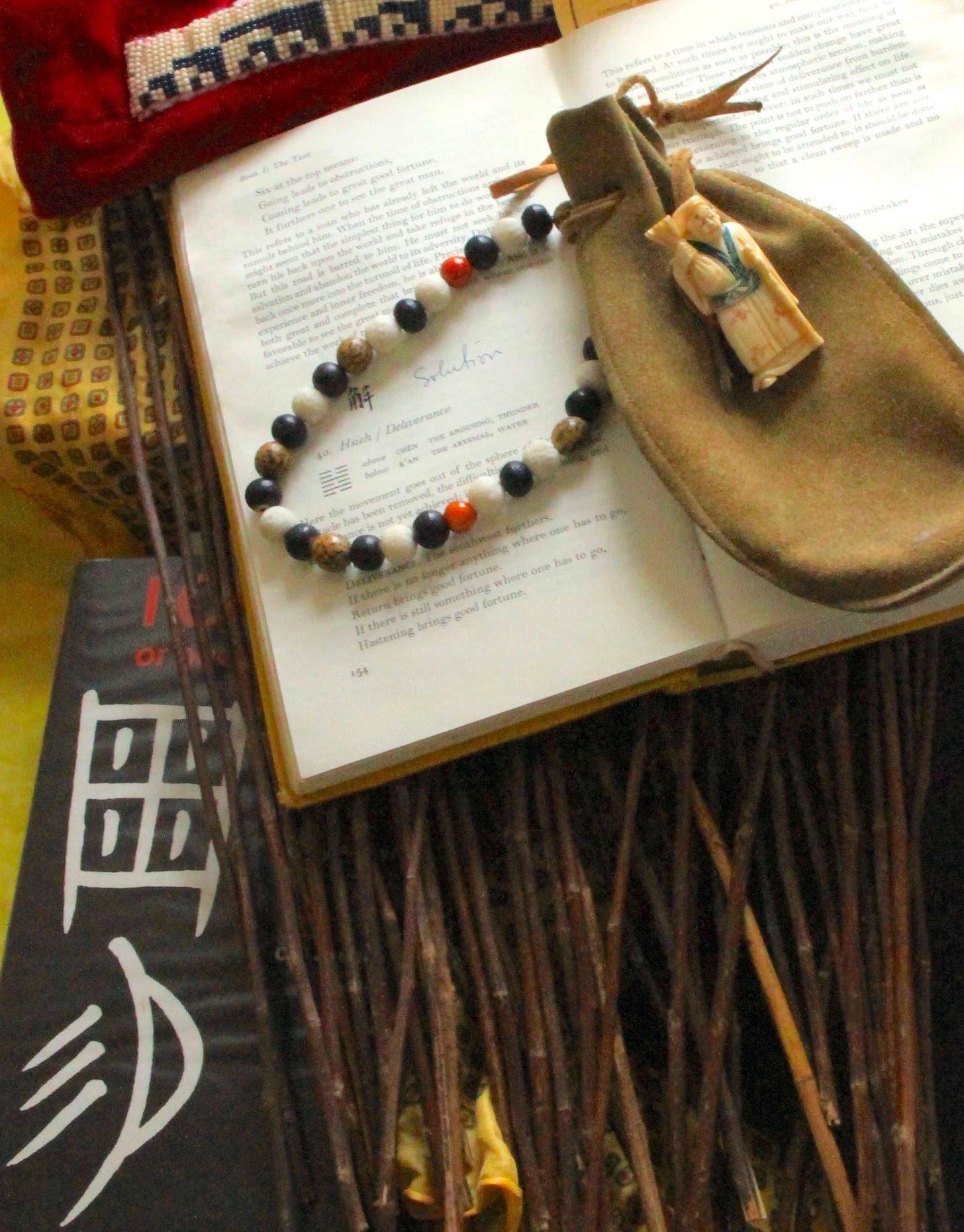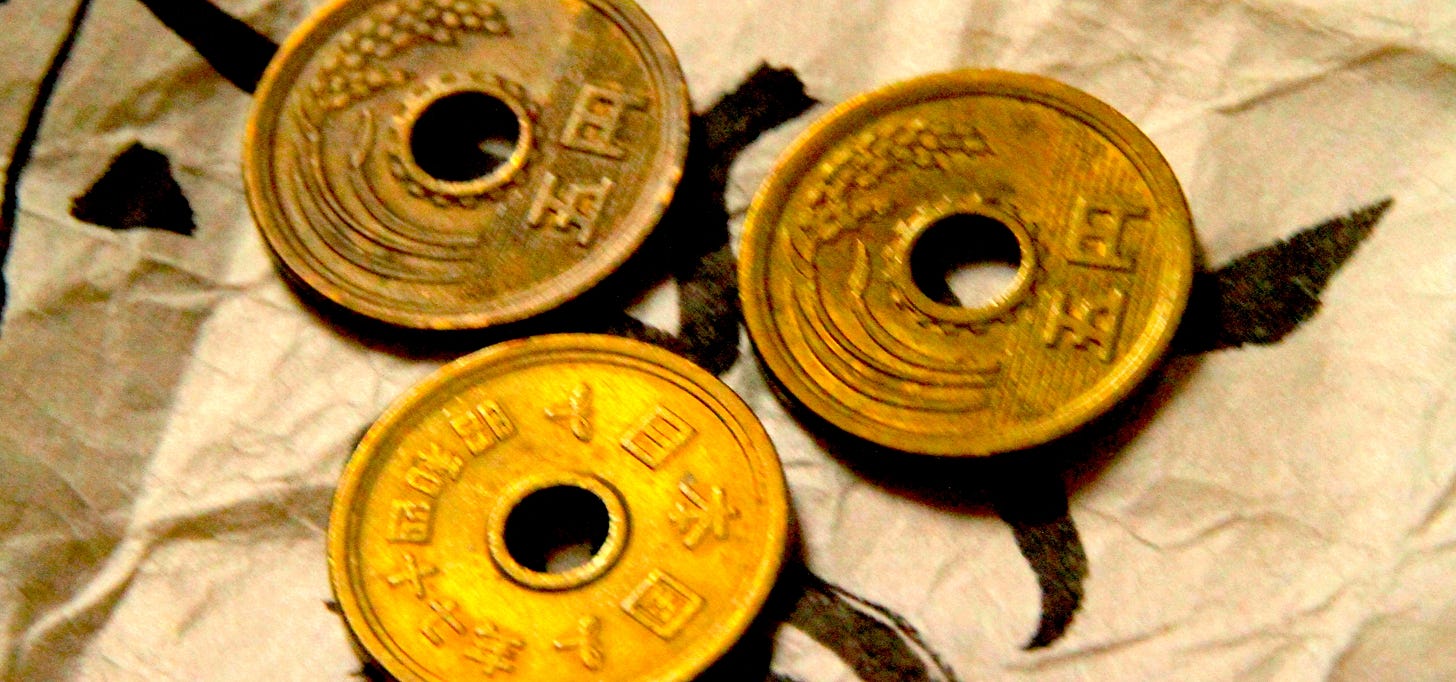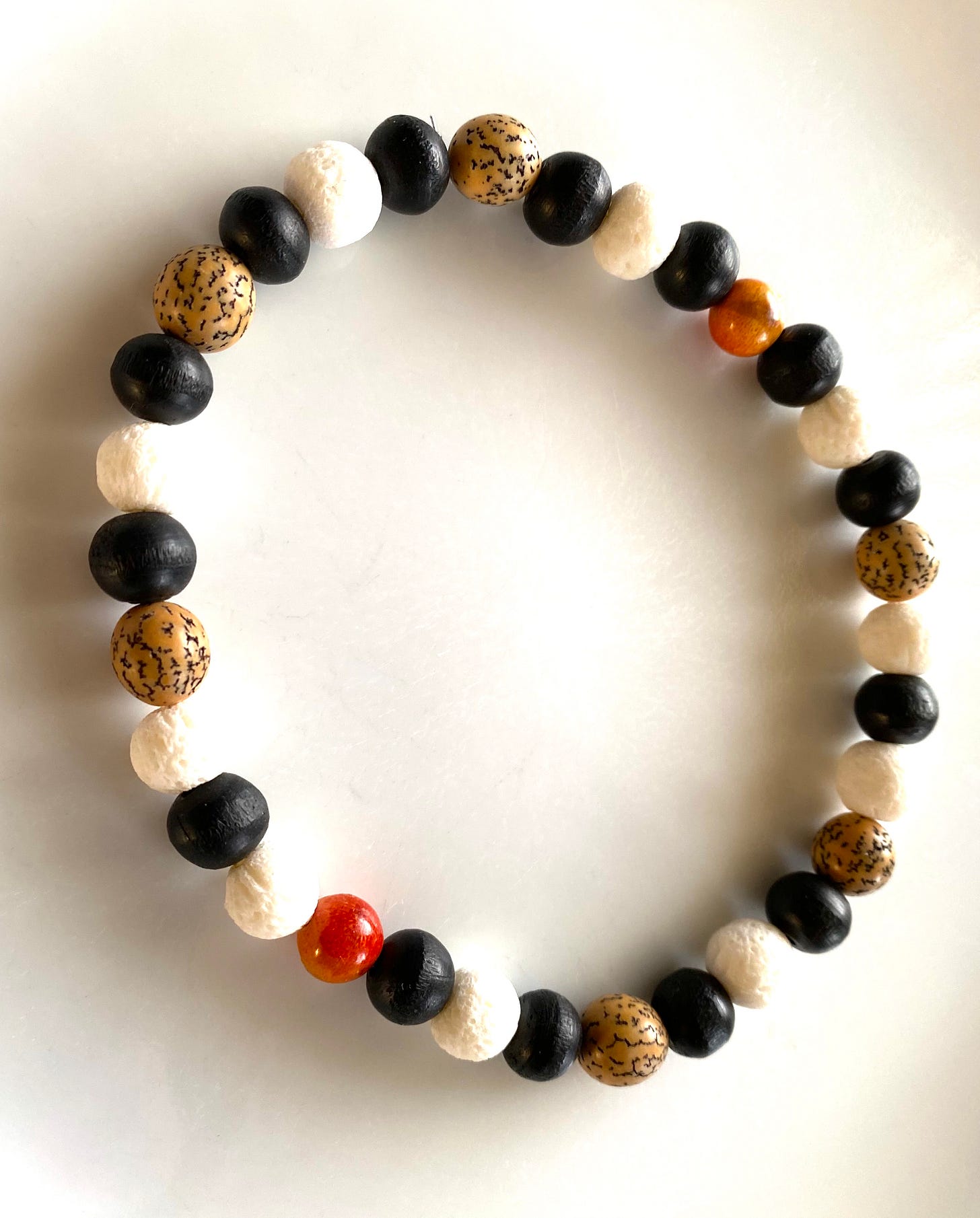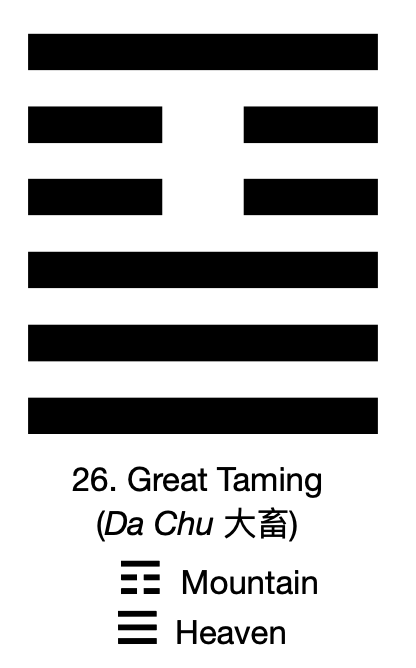This articles explains the use of ‘Practical Yijing Reading Beads,’ a tool that can be used in accessing the hexagrams in the course of Yijing reading.
The ‘Change Classic’ or ‘Book of Changes’ (易經) is one of the ‘Thirteen Confucian Classics’ (十三經). It has informed people of Asian lands for more than two-thousand five-hundred years. Organized by a series of symbols called ‘hexagrams’ (gua 卦), the Yijing (also spelled I Ching) is now used throughout the world as a guidance tool, usually as an aid to decision making.
Some people read the Yijing daily for inspiration. Others use it to help pass through difficult decision-making times. Birthday or New Year’s readings are a must for some users. Many taijiquan players use the Yijing to help guide their training and move themselves further along the self-cultivation path. I myself consult the Yijing when I have a situation or problem, usually personal, that I am unable to come to terms using with my normal reckoning and intuition. Diving into this wellspring of wisdom is deeply rewarding, often surprising and always fun!

Hexagrams, unigrams, and trigrams
To establish which part of the Yijing one is to reflect upon in relation to a specific question or topic, one must first obtain one of the sixty-four ‘hexagrams.’ Hexagrams are the six-lined images (hexa meaning ‘six’ and gram meaning ‘image’) that are the basis for much of the content and structure of the work. Below is an example of a hexagram.
The raw materials for the formation of hexagrams are single-line ‘unigrams’ (yao 爻)—often described simply as ‘lines’—that are defined as either ‘yin’ or ‘yang’ (陰, 陽). A yin line is depicted by the broken yao (- -) while a yang line shows a solid yao (—). Yin and yang lines combine to form a six-lined hexagram; as in the example ䷼ above.
Hexagrams are also understood to be a combination of two ‘trigrams’—three-lined images (tri meaning ‘three’ and gram meaning ‘image’). In the case of ䷼, there is the trigram ☱ (lake; dui) below and the trigram ☴ (wind; xun) above.
Traditionally, hexagrams are analyzed from the bottom up, therefore, the lines of the hexagram Zhongfu ䷼ above can be read as: 1. yang 2. yang 3. yin 4. yin 5. yang 6. yang.
If one were to have established Zhongfu ䷼ as the hexagram to be read, the next step would be to find it in the Yijing—it is the 61st hexagram—and begin reading and pondering the advice therein.
Yin, yang, and taiyin, taiyang
Together, yin and yang are called ‘taiji’ (taiji 太極) meaning the ‘great extremes,’ the ‘grand polarities, or the ‘supreme ultimate.’ The concept is also depicted in the famed ‘taiji diagram’ (taiji tu 太極圖) which is also called the ‘yin-yang circle.’
According to the traditional yin-yang theory, when yin reaches it’s most extreme yin-state it must change and become yang. This extremely ebbed yin phase is known as ‘taiyin’ (太陰). Similarly, when yang reaches its extreme apex it becomes ‘taiyang’ (太陽) and must now change to become yin.
In Yijing-hexagram reading, taiyin lines are depicted as a yin line with a cross through the middle (-x-) and indicate that a change to (—) is imminent. In a similar fashion, taiyang lines, depicted as a yang line with a circle in the middle (see hexagram below), indicate a change to (- -). Taiyin and taiyang lines are thought to indicate a changing situation and can be used to generate a second ‘probable outcome’ hexagram.
For example, if the reader selects Zhongfu but there is a taiyin line in the third position and a taiyang line in the fifth position, it would indicate that these lines are about to change and that a new hexagram will soon become relevant. In Yijing reading, this newly generated hexagram represents the ‘probable outcome.’
Yarrow-stalk and coin-tossing line probabilities
The two most common traditional methods for obtaining a hexagram are the ‘yarrow-stalk method,’ which involves the methodical and repetitive counting off of fifty stalks from the yarrow plant, and the ‘coin-tossing method,’ in which three coins are thrown to indicate yin and yang lines.
The yarrow-stalk method provides a set of line-selection probabilities that is thought to reflect aspects of the inner structure of the Yijing. The yarrow stalk method is, however, laborious and time consuming. Therefore, most practitioners utilize the more convenient coin-tossing method.
The probabilities for selection of yin, yang, taiyin, and taiyang lines that is a feature of the ancient yarrow-stalk method are, problematically, not reflected in the coin-tossing method.

Practical Yijing Reading Beads
To solve the problem posed by the arduousness of the yarrow-stalk method, as well as the even-probability issue with coin tossing, in ingenious solution was advanced by my first Yijing mentor Dr. Jay Dunbar, himself a taijiquan and Yijing study disciple of Master Jou Tsung Hwa (The Tao of I Ching: Way to Divination, The Dao of Taijiquan: Way to Rejuvenation), whereby the reader uses beads in the selection of the hexagram. The meditative and contemplative features of Yijing reading are enhanced by the use of the reading beads which have a ‘prayer-bead’ or ‘meditation-bead’ like quality. As well, they are portable and very easy to use in the establishment of a hexagram.
The hexagram outcomes of the Practical Yijing Reading Beads perfectly reflect the yarrow-stalk probabilities.

The four colours of the sixteen beads represent the yin, yang, taiyang, and taiyin lines used in building a hexagram.
Yin (- -) is represented by the 7 black beads.
Yang (—) is represented by the 5 white beads.
Taiyang (-o-) is represented by the 3 yellowed beads.
Taiyin (-x-) is represented by the 1 red bead.
Yijing bead reading step-by-step
You will need
• A copy of the Yijing. (Examples used here are from the Richard Wilhelm version which is available in English, German, Spanish, Italian, and French)
• Practical Yijing Reading Beads.
• A quiet space.
• Pencil and paper.
Instructions
Form and ask your question. When forming your question, ask for insight, advice, or guidance rather than for specific knowledge of desired outcome.
Write a list of the numbers from 1 to 6 (with 1 at the bottom).
While contemplating your question, take your reading beads in one hand, using the other hand to pass the beads through your fingers.
When you feel the impulse to ‘stop,’ pinch one bead and identify it.
Starting at number one (on the bottom of your list), notate the line symbol represented by the bead. For example, if you pinch a black bead, write the unigram - - (yin) next to the number one.
Repeat this process until you have established lines for each of the six places. You have thus obtained a six-lined hexagram.
Using the table found in the back of the Yijing (in the Wilhelm version) find the
number of your new hexagram and look it up in the early part of the book called THE TEXT. (Ignore the taiyin and taiyang lines at this stage, treating taiyin as yin and taiyang as yang.)a) Study the ‘trigram formation’ of the hexagram: For example in Hexagram 26, Da Chu (䷙ 大畜) ‘Taming Power of the Great’ or ‘Great Taming,’ the relationship is of ‘mountain’ above ‘heaven.’ Contemplate the possible significance of these images and their relationship.
b) Read THE JUDGEMENT and THE IMAGE. Contemplate the significance of the ideas contained therein.
c) If there are changing lines in your reading, for example, if you have a changing taiyin line in the fifth place of the hexagram, read the fifth of THE LINES which will begin with ‘Six in the fifth place means...’ Contemplate the significance of the changing nature of that line.
If you have one or more changing lines, generate a ‘probable-outcome’ hexagram by altering the changing taiyin line into its opposite; for example the taiyin line
(-x-) in the fifth place of Great Taming (Hexagram 26) now becomes yang (—) to generate Hexagram 9: Xiao Chu (䷈ 小畜) ‘Taming Power of the Small’ or ‘Small Taming.’ Study the trigram formation, JUDGEMENT and IMAGE of the probable-outcome hexagram. Contemplate the significance of the transformation that has taken place between the two hexagrams; in this case how ‘Great Taming’ relates to ‘Small Taming’ with regard to your question.

‘Great Taming,’ when with a changing line in the fifth position, engenders the probable outcome of ‘Small Taming.’ What does this suggest? In addition to the probable-outcome hexagram, there are many other hexagram variations that can be derived once the initial hexagram has been established using the bead-reading method. As well, other steps may be introduced into the process such as those found in ‘Yijing Focusing’ work. Considering the millenniums-old history of the Change Classic, it is not surprising that Yijing enthusiasts might devote decades to continual research and refinement.
©2023 Masich Internal Arts, Sam Masich













Hi Lynda. Thanks for your comment. I sell the Practical Yijing Reading Beads for $75. I can mail them or bring them to the UK in July when I am there.
Best wishes,
Sam
Hi Sam thanks for the article about the Yijing. I would really love a set of your Yijing beads if possible? I switched from coins to yarrow stalks but now I hardly ever have enough quiet time to do a reading. The beads sound like a brilliant solution!